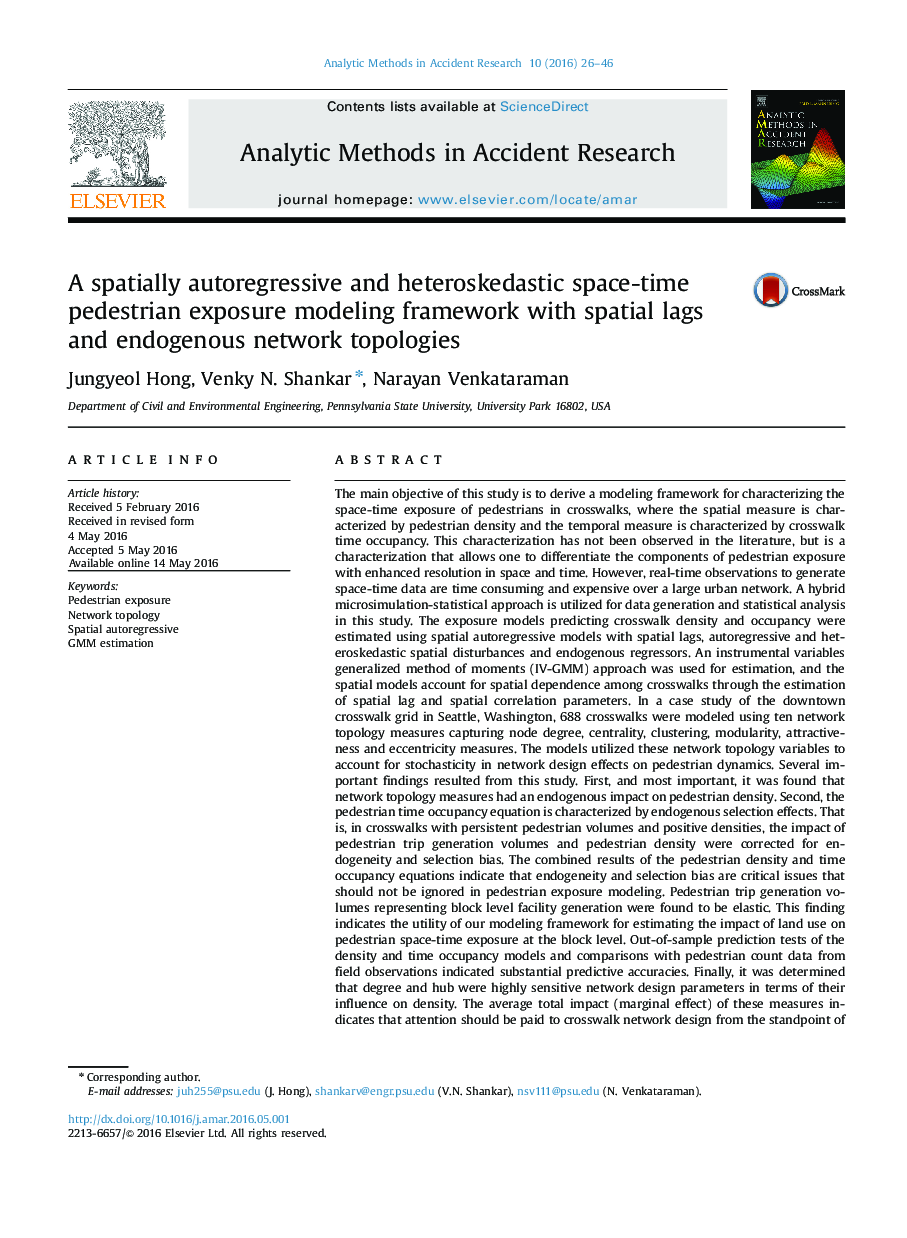| کد مقاله | کد نشریه | سال انتشار | مقاله انگلیسی | نسخه تمام متن |
|---|---|---|---|---|
| 1104493 | 1488237 | 2016 | 21 صفحه PDF | دانلود رایگان |
• Article considers a space-time model of pedestrian exposure using density and time occupancy.
• Provides insight into spatial dependence and autocorrelation.
• Provides insights into the a method for accommodating endogenous network topologies.
• Shows that the space-time approach is useful for characterizing pedestrian exposure accurately based on validations.
The main objective of this study is to derive a modeling framework for characterizing the space-time exposure of pedestrians in crosswalks, where the spatial measure is characterized by pedestrian density and the temporal measure is characterized by crosswalk time occupancy. This characterization has not been observed in the literature, but is a characterization that allows one to differentiate the components of pedestrian exposure with enhanced resolution in space and time. However, real-time observations to generate space-time data are time consuming and expensive over a large urban network. A hybrid microsimulation-statistical approach is utilized for data generation and statistical analysis in this study. The exposure models predicting crosswalk density and occupancy were estimated using spatial autoregressive models with spatial lags, autoregressive and heteroskedastic spatial disturbances and endogenous regressors. An instrumental variables generalized method of moments (IV-GMM) approach was used for estimation, and the spatial models account for spatial dependence among crosswalks through the estimation of spatial lag and spatial correlation parameters. In a case study of the downtown crosswalk grid in Seattle, Washington, 688 crosswalks were modeled using ten network topology measures capturing node degree, centrality, clustering, modularity, attractiveness and eccentricity measures. The models utilized these network topology variables to account for stochasticity in network design effects on pedestrian dynamics. Several important findings resulted from this study. First, and most important, it was found that network topology measures had an endogenous impact on pedestrian density. Second, the pedestrian time occupancy equation is characterized by endogenous selection effects. That is, in crosswalks with persistent pedestrian volumes and positive densities, the impact of pedestrian trip generation volumes and pedestrian density were corrected for endogeneity and selection bias. The combined results of the pedestrian density and time occupancy equations indicate that endogeneity and selection bias are critical issues that should not be ignored in pedestrian exposure modeling. Pedestrian trip generation volumes representing block level facility generation were found to be elastic. This finding indicates the utility of our modeling framework for estimating the impact of land use on pedestrian space-time exposure at the block level. Out-of-sample prediction tests of the density and time occupancy models and comparisons with pedestrian count data from field observations indicated substantial predictive accuracies. Finally, it was determined that degree and hub were highly sensitive network design parameters in terms of their influence on density. The average total impact (marginal effect) of these measures indicates that attention should be paid to crosswalk network design from the standpoint of degree and hub characteristics. These results show that our space-time density-occupancy modeling framework is a plausible and efficient predictive tool that can be used to estimate pedestrian crosswalk exposure using building level and network topology data alone. We find that the IV-GMM technique is a useful approach for the emergent problem of inference in hybrid simulation-statistical transportation datasets, due to fewer assumptions on distributional assumptions about the data, while accounting for statistical effects relating to endogeneity, potential selection effects and heteroscedasticity.
Journal: Analytic Methods in Accident Research - Volume 10, June 2016, Pages 26–46
